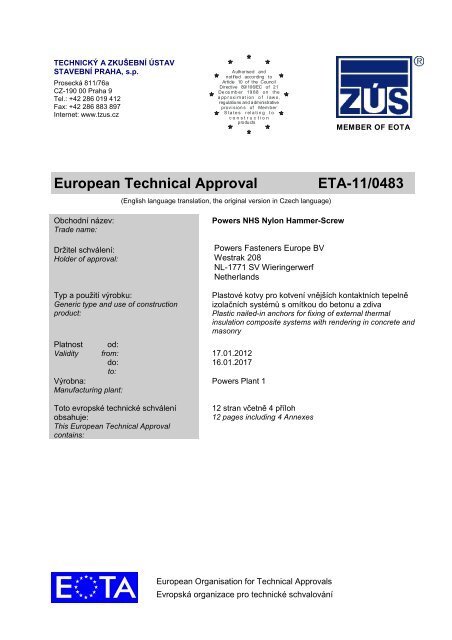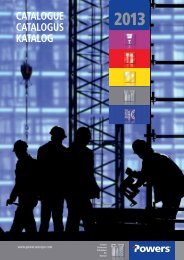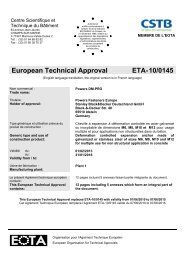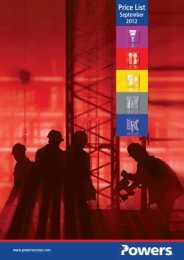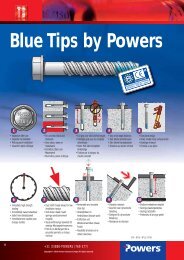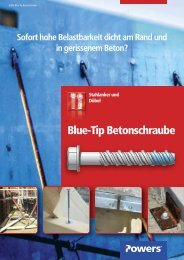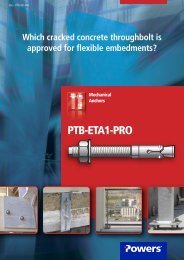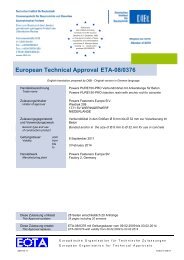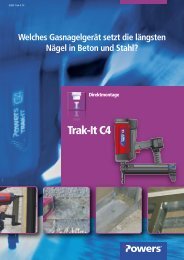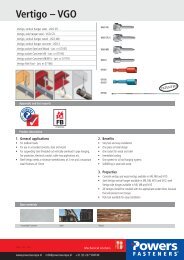European Technical Approval ETA-11/0483 - bei Powers Europe
European Technical Approval ETA-11/0483 - bei Powers Europe
European Technical Approval ETA-11/0483 - bei Powers Europe
You also want an ePaper? Increase the reach of your titles
YUMPU automatically turns print PDFs into web optimized ePapers that Google loves.
TECHNICKÝ A ZKUŠEBNÍ ÚSTAV<br />
STAVEBNÍ PRAHA, s.p.<br />
Prosecká 8<strong>11</strong>/76a<br />
CZ-190 00 Praha 9<br />
Tel.: +42 286 019 412<br />
Fax: +42 286 883 897<br />
Internet: www.tzus.cz<br />
Authorised and<br />
notified according to<br />
Article 10 of the Council<br />
Directive 89/106/EC of 21<br />
De ce mb er 19 88 on the<br />
a pp r oxi m at i on o f l aw s,<br />
regulations and administrative<br />
provi sion s of Mem ber<br />
S ta te s r el a ti n g t o<br />
c o n s t r u c t i o n<br />
products<br />
MEMBER OF EOTA<br />
®<br />
<strong><strong>Europe</strong>an</strong> <strong>Technical</strong> <strong>Approval</strong><br />
(English language translation, the original version in Czech language)<br />
<strong>ETA</strong>-<strong>11</strong>/<strong>0483</strong><br />
Obchodní název:<br />
Trade name:<br />
Držitel schválení:<br />
Holder of approval:<br />
<strong>Powers</strong> NHS Nylon Hammer-Screw<br />
<strong>Powers</strong> Fasteners <strong>Europe</strong> BV<br />
Westrak 208<br />
NL-1771 SV Wieringerwerf<br />
Netherlands<br />
Typ a použití výrobku:<br />
Generic type and use of construction<br />
product:<br />
Platnost od:<br />
Validity from: 17.01.2012<br />
do:<br />
16.01.2017<br />
to:<br />
Výrobna:<br />
<strong>Powers</strong> Plant 1<br />
Manufacturing plant:<br />
Plastové kotvy pro kotvení vnějších kontaktních tepelně<br />
izolačních systémů s omítkou do betonu a zdiva<br />
Plastic nailed-in anchors for fixing of external thermal<br />
insulation composite systems with rendering in concrete and<br />
masonry<br />
Toto evropské technické schválení<br />
obsahuje:<br />
This <strong><strong>Europe</strong>an</strong> <strong>Technical</strong> <strong>Approval</strong><br />
contains:<br />
12 stran včetně 4 příloh<br />
12 pages including 4 Annexes<br />
<strong><strong>Europe</strong>an</strong> Organisation for <strong>Technical</strong> <strong>Approval</strong>s<br />
Evropská organizace pro technické schvalování
Page 2 of 12 of <strong>ETA</strong>-<strong>11</strong>/<strong>0483</strong>, issued on 17.01.2012, valid till 16.01.2017<br />
English translation by TZÚS Praha<br />
I. LEGAL BASES AND GENERAL CONDITIONS<br />
1. This <strong><strong>Europe</strong>an</strong> <strong>Technical</strong> <strong>Approval</strong> is issued by the <strong>Technical</strong> and Test Institute for<br />
Construction Prague (Technický a zkušební ústav stavební Praha, s.p.) in<br />
accordance with:<br />
• Council Directive 89/106/EEC of 21 December 1988 on the approximation of<br />
laws, regulations and administrative provisions of Member States relating to<br />
construction products 1 , modified by the Council Directive 93/68/EEC 2 ; and<br />
Regulation (EC) No.1882/2003 of the <strong><strong>Europe</strong>an</strong> Parliament and of the Council 3 ;<br />
• the Government Decree No. 190/2002 Collection of Laws 4 , as amended;<br />
• Common Procedural Rules for Requesting, Preparing and the Granting of<br />
<strong><strong>Europe</strong>an</strong> <strong>Technical</strong> <strong>Approval</strong>s set out in the Annex to Commission Decision<br />
94/23/EC 5 ;<br />
• Guideline for <strong><strong>Europe</strong>an</strong> <strong>Technical</strong> <strong>Approval</strong> of „Plastic Anchors for Fixing of<br />
External Thermal Insulation Composite Systems with Rendering“, <strong>ETA</strong>G 014,<br />
Edition January 2002.<br />
2. The <strong>Technical</strong> and Test Institute for Construction Prague is authorised to check<br />
whether the provisions of this <strong><strong>Europe</strong>an</strong> <strong>Technical</strong> <strong>Approval</strong> are met. Checking may<br />
take place in the manufacturing plant. Nevertheless, the responsibility for the<br />
conformity of the products to the <strong><strong>Europe</strong>an</strong> <strong>Technical</strong> <strong>Approval</strong> and for their fitness for<br />
the intended use remains with the holder of the <strong><strong>Europe</strong>an</strong> <strong>Technical</strong> <strong>Approval</strong>.<br />
3. This <strong><strong>Europe</strong>an</strong> <strong>Technical</strong> <strong>Approval</strong> is not to be transferred to manufacturers or agents<br />
of manufacturer other than those indicated on page 1, or manufacturing plants other<br />
than those laid down in the context of this <strong><strong>Europe</strong>an</strong> <strong>Technical</strong> <strong>Approval</strong>.<br />
4. This <strong><strong>Europe</strong>an</strong> <strong>Technical</strong> <strong>Approval</strong> may be withdrawn by the <strong>Technical</strong> and Test<br />
Institute for Construction Prague in particular pursuant to information by the<br />
Commission according to Article 5.1 of the Council Directive 89/106/EEC.<br />
5. Reproduction of this <strong><strong>Europe</strong>an</strong> <strong>Technical</strong> <strong>Approval</strong> including transmission by<br />
electronic means shall be in full. However, partial reproduction can be made with the<br />
written consent of the <strong>Technical</strong> and Test Institute for Construction Prague. In this<br />
case, partial reproduction has to be designated as such. Texts and drawings of<br />
advertising brochures shall not contradict or misuse the <strong><strong>Europe</strong>an</strong> <strong>Technical</strong><br />
<strong>Approval</strong>.<br />
6. The <strong><strong>Europe</strong>an</strong> <strong>Technical</strong> <strong>Approval</strong> is issued by the approval body in its official<br />
language. This version corresponds fully to the version circulated within EOTA.<br />
Translations into other languages have to be designated as such.<br />
1 Official Journal of the <strong><strong>Europe</strong>an</strong> Communities N o L 40, <strong>11</strong>.02.1989, p. 12<br />
2 Official Journal of the <strong><strong>Europe</strong>an</strong> Communities N o L 220, 30.08.1993, p. 1<br />
3 Official Journal of the <strong><strong>Europe</strong>an</strong> Union no. L 284, 31.10.2003, p. 1<br />
4 Collection of Law of the Czech Republic Vol.79 No190 , 21.5.2002<br />
5 Official Journal of the <strong><strong>Europe</strong>an</strong> Communities N o L 17, 20.01.1994, p. 34<br />
090-026293
Page 3 of 12 of <strong>ETA</strong>-<strong>11</strong>/<strong>0483</strong>, issued on 17.01.2012, valid till 16.01.2017<br />
English translation by TZÚS Praha<br />
II.<br />
SPECIFIC CONDITIONS OF THE EUROPEAN TECHNICAL<br />
APPROVAL<br />
1 Definition of product and intended use<br />
1.1 Definition of product<br />
The nailed-in plastic anchors <strong>Powers</strong> NHS Nylon Hammer-Screw consist of a plastic<br />
sleeve with a collar for fixing the profiles for thermal insulation system (ETICS) and an<br />
expansion screw. The anchor sleeve is made of polyamide PA 6 and the accompanying<br />
specific expansion screw is made of zinc plated steel or of stainless steel.<br />
The anchor is installed in drilled hole by hammering in the expansion screw.<br />
The installed anchor is shown in Annex 1.<br />
1.2 Intended use<br />
The anchor is intended to be used for anchorages for which requirements for safety<br />
in use in the sense of the Essential Requirement 4 of Council Directive 89/106/EEC<br />
shall be fulfilled and failure of anchorages made with these products would cause<br />
low risk to human life. The anchor is to be used only as multiple fixing for the<br />
anchorage of profiles for bonded thermal insulation composite systems (ETICS)<br />
according to <strong>ETA</strong>G 004 in concrete and masonry. The base material shall consist of<br />
reinforced or unreinforced normal weight concrete of strength class C12/15 at<br />
minimum and C50/60 at maximum according to EN 206-1:2000-12 and of masonry<br />
walls made of solid clay bricks according to EN 771-1 or calcium silicate units<br />
according to EN 771-2.<br />
The anchor may only be used for transmission of wind suction loads and shall not<br />
be used for the transmission of dead loads of the thermal insulation composite<br />
system. The dead loads have to be transmitted by the bonding of the thermal<br />
insulation composite system.<br />
The anchor may be used with the accompanying specific screw of stainless steel or<br />
with a thermal insulation cover of at least 50 mm and the accompanying specific<br />
screw of galvanised steel.<br />
The provisions made in this <strong><strong>Europe</strong>an</strong> <strong>Technical</strong> <strong>Approval</strong> are based on an<br />
assumed working life of the anchor of 25 years. The indications given on the<br />
working life cannot be interpreted as a guarantee given by the producer, but are to<br />
be regarded only as a means for choosing the products in relation to the expected<br />
economically reasonable working life of the works.<br />
2 Characteristics of the product and methods of verification<br />
2.1 Characteristics of the product<br />
The anchor corresponds to the drawings and information given in Annexes 2 - 4.<br />
The characteristic material values, dimensions and tolerances of the anchor not<br />
indicated in these Annexes shall correspond to the respective values laid down in<br />
the technical documentation 6 of this <strong><strong>Europe</strong>an</strong> <strong>Technical</strong> <strong>Approval</strong>.<br />
The characteristic values for the design of the anchorages are given in Annexes 3 - 4.<br />
Each anchor is to be marked with the producer name, type, the diameter and the<br />
length of the anchor.<br />
The anchor shall only be packaged and supplied as a complete unit.<br />
6 The technical documentation of this <strong>Europe</strong>n <strong>Technical</strong> <strong>Approval</strong> is deposited at the Technický a zkušební ústav<br />
stavební Praha, s.p, as far as relevant for the tasks of the approved bodies involved in the attestation of conformity<br />
producer, is handed over to the approved bodies.<br />
090-026293
Page 4 of 12 of <strong>ETA</strong>-<strong>11</strong>/<strong>0483</strong>, issued on 17.01.2012, valid till 16.01.2017<br />
English translation by TZÚS Praha<br />
2.2 Methods of verification<br />
The assessment of the fitness of the anchor for the intended use in relation to the<br />
requirements for safety in use in the sense of Essential Requirement 4 has been<br />
made in compliance with:<br />
- the Guideline for <strong><strong>Europe</strong>an</strong> <strong>Technical</strong> <strong>Approval</strong> of "Plastic Anchors for Fixing of<br />
External Thermal Insulation Composite Systems with Rendering", <strong>ETA</strong>G 014,<br />
based on the use categories A, B.<br />
In addition to the specific clauses relating to dangerous substances contained in this<br />
<strong><strong>Europe</strong>an</strong> <strong>Technical</strong> <strong>Approval</strong>, there may be other requirements applicable to the<br />
products falling within its scope (e.g. transposed <strong><strong>Europe</strong>an</strong> legislation and national<br />
laws, regulations and administrative provisions). In order to meet the provisions of<br />
the Construction Products Directive, these requirements need also to be complied<br />
with, when and where they apply.<br />
3 Evaluation of conformity of the product and CE marking<br />
3.1 System of attestation of conformity<br />
According to the decision 97/463/EC of the <strong><strong>Europe</strong>an</strong> Commission the system 2+ of<br />
attestation of conformity applies. This system of attestation of conformity is<br />
described in Annex III, 2(ii), first possibility to the Construction Products Directive as<br />
follows.<br />
System 2+: Declaration of conformity of the product by the manufacturer on the<br />
basis of:<br />
(a)<br />
(b)<br />
3.2 Responsibility<br />
Tasks of the manufacturer:<br />
(1) initial type-testing of the product;<br />
(2) factory production control;<br />
(3) testing of samples taken at the factory by the manufacturer in accordance<br />
with a control plan.<br />
Tasks of the approved body:<br />
(4) certification of factory production control on the basis of:<br />
- initial inspection of factory and of factory production control;<br />
- continuous surveillance, assessment and approval of factory production<br />
control.<br />
3.2.1 Tasks of the manufacturer<br />
3.2.1.1 Factory production control<br />
The manufacturer shall exercise permanent internal control of production. All the<br />
elements, requirements and provisions adopted by the manufacturer shall be<br />
documented in a systematic manner in the form of written policies and procedures,<br />
including records of results performed. This production control system shall insure<br />
that the product is in conformity with this <strong><strong>Europe</strong>an</strong> <strong>Technical</strong> <strong>Approval</strong>.<br />
The manufacturer may only use raw materials stated in the technical documentation<br />
of this <strong><strong>Europe</strong>an</strong> <strong>Technical</strong> <strong>Approval</strong>.<br />
The factory production control shall be in accordance with the control plan of which<br />
is part of the technical documentation of this <strong><strong>Europe</strong>an</strong> <strong>Technical</strong> <strong>Approval</strong>. The<br />
control plan is laid down in the context of the factory production control system<br />
operated by the manufacturer and deposited at TZÚS Praha s.p 7 .<br />
7 The control plan is a confidential part of the documentation of the <strong><strong>Europe</strong>an</strong> <strong>Technical</strong> <strong>Approval</strong>, but not published<br />
together with the <strong>ETA</strong> and only handed over to the approved body involved in the procedure of attestation of<br />
conformity. See section 3.2.2.<br />
090-026293
Page 5 of 12 of <strong>ETA</strong>-<strong>11</strong>/<strong>0483</strong>, issued on 17.01.2012, valid till 16.01.2017<br />
English translation by TZÚS Praha<br />
The results of factory production control shall be recorded and evaluated in<br />
accordance with the provisions of the control plan.<br />
3.2.1.2 Other tasks of manufacture<br />
The manufacturer shall, on the basis of a contract, involve a body which is approved<br />
for the tasks referred to in section 3.1 in the field of anchors in order to undertake<br />
the actions laid down in section 3.2.2. For this purpose, the control plan referred to<br />
in sections 3.2.1.1 and 3.2.2 shall be handed over by the manufacturer to the<br />
approved body involved. The manufacturer shall make a declaration of conformity,<br />
stating that the construction product is in conformity with the provisions of this<br />
<strong><strong>Europe</strong>an</strong> <strong>Technical</strong> <strong>Approval</strong>.<br />
3.2.2 Tasks of approved bodies<br />
The approved body shall perform the:<br />
- initial inspection of factory and of factory production control,<br />
- continuous surveillance, assessment and approval of factory production control in<br />
accordance with the provisions laid down in the control plan.<br />
The approved body shall retain the essential points of its actions referred to above<br />
and state the results obtained and conclusions drawn in a written report.<br />
The approved certification body involved by the manufacturer shall issue an EC<br />
certificate of conformity of the factory production control stating the conformity with<br />
the factory production control of this <strong><strong>Europe</strong>an</strong> <strong>Technical</strong> <strong>Approval</strong>.<br />
In cases where the provisions of the <strong><strong>Europe</strong>an</strong> <strong>Technical</strong> <strong>Approval</strong> and its control plan<br />
are no longer fulfilled the approved body shall withdraw the certificate of conformity<br />
and inform TZÚS Praha, s.p. without delay.<br />
3.3 CE marking<br />
The CE-marking 8 shall be affixed on each packaging of the anchor. The symbol<br />
“CE“ shall be accopanied by the following information:<br />
- name or identifying mark of producer and manufacturing plant;<br />
- identifying mark of product;<br />
- identification number of an approved body;<br />
- the last two digits of the year in which the CE-marking was affixed;<br />
- the number of the <strong><strong>Europe</strong>an</strong> <strong>Technical</strong> <strong>Approval</strong>;<br />
- the number of the guideline for <strong><strong>Europe</strong>an</strong> <strong>Technical</strong> <strong>Approval</strong>;<br />
- the number of ES certificate of FPC;<br />
- use categories (A, B).<br />
4 Assumptions under which the fitness of the product for the<br />
intended use was favourably assessed<br />
4.1 Manufacturing<br />
The anchor is manufactured in accordance with the provisions of the <strong><strong>Europe</strong>an</strong><br />
<strong>Technical</strong> <strong>Approval</strong> using the semi automated and automated manufacturing<br />
process as verified by the inspection of the plant performed by the Technický<br />
a zkušební ústav stavební Praha, s.p. as laid down in the technical documentation.<br />
The <strong><strong>Europe</strong>an</strong> <strong>Technical</strong> <strong>Approval</strong> is issued for the product on the basis of agreed<br />
data/information, deposited with TZÚS Praha, s.p, which identifies the product that<br />
has been assessed and judged. Changes to the product or production process,<br />
which could result in this deposited data/information <strong>bei</strong>ng incorrect, should be<br />
8<br />
Notes on the CE marking are stated in Guidance Paper D „CE marking under the Construction Products<br />
Directive“, Brussels, 01 August 2002<br />
090-026293
Page 6 of 12 of <strong>ETA</strong>-<strong>11</strong>/<strong>0483</strong>, issued on 17.01.2012, valid till 16.01.2017<br />
English translation by TZÚS Praha<br />
approved to TZÚS Praha, s.p before the changes are introduced. TZÚS Praha, s.p<br />
will decide whether or not such changes affect the <strong>ETA</strong> and consequently the<br />
validity of the CE marking on the basis of the <strong>ETA</strong> and if so whether further<br />
assessment or alterations to the <strong>ETA</strong> shall be necessary.<br />
4.2 Installation<br />
4.2.1 Design of anchorages<br />
4.2.1.1 General<br />
The <strong>ETA</strong> only applies to the manufacture and use of the anchor. Verification of<br />
stability of the external thermal insulation composite system including application of<br />
load on the anchor is not subject of this <strong><strong>Europe</strong>an</strong> <strong>Technical</strong> <strong>Approval</strong>.<br />
Fitness for the intended use of the anchor is given under the following conditions:<br />
The design of anchorages is carried out in compliance with <strong>ETA</strong>G 014 ”Guideline for<br />
<strong><strong>Europe</strong>an</strong> <strong>Technical</strong> <strong>Approval</strong> of Plastic Anchors for Fixing of External Thermal<br />
Insulation Composite Systems with Rendering“ under the responsibility of an<br />
engineer experienced in anchorages.<br />
Verifiable calculation notes and drawings shall be prepared taking account of the loads<br />
to be anchored, the nature and strength of the base materials, the thickness of<br />
insulation and the dimensions of the anchorage as well as of the relevant tolerances.<br />
Proof of direct local application of load on the base material shall be delivered. The<br />
anchor shall only be used for the transmission of wind suction loads. All other loads<br />
such as dead load and restraints shall be transmitted by the adhesion of the relevant<br />
external thermal insulation composite system.<br />
4.2.1.2 Resistance<br />
The characteristic values of the tension resistance of the anchor are given in Table<br />
5, Annex 4. If there is a difference to the given characteristic values of the base<br />
material or use of similar base material of category B supposed; the job-site tests<br />
according to 4.2.3 shall be carried out and the characteristic tension resistance shall<br />
be determined.<br />
4.2.1.3 Characteristic values, spacing and dimensions of anchorage member<br />
The minimum spacing and dimensions of anchorage member according to the<br />
Annex 3 shall be observed.<br />
4.2.1.4 Displacement behavior<br />
The displacement are given in the following table<br />
Concrete C16/20 - C50/60 Solid clay brick Calcium silicate solid units<br />
Tension<br />
Tension<br />
Tension<br />
Displacement<br />
Displacement<br />
load<br />
load<br />
load<br />
Displacement<br />
N Sk [kN] ∆δ N [mm] N Sk [kN] ∆δ N [mm] N Sk [kN] ∆δ N [mm]<br />
NHS 5 0,3 0,69 0,3 0,59 0,3 0,52<br />
NHS 6 0,5 0,77 0,4 0,49 0,5 0,63<br />
NHS 8 0,5 0,67 0,5 0,62 0,5 0,81<br />
4.2.2 Installation of anchor<br />
The fitness for use of the anchor can only be assumed if the following conditions of<br />
installation are met:<br />
- Anchor installation carried out by appropriately qualified personnel under the<br />
supervision of the person responsible for technical matters on site.<br />
- Use of the anchor only as supplied by the manufacturer without exchanging any<br />
component of the anchor.<br />
090-026293
Page 7 of 12 of <strong>ETA</strong>-<strong>11</strong>/<strong>0483</strong>, issued on 17.01.2012, valid till 16.01.2017<br />
English translation by TZÚS Praha<br />
- Anchor installation in accordance with the manufacturer’s specifications and<br />
drawings using the appropriate tools.<br />
- Checks before placing the anchor, to ensure that the characteristic values of the<br />
base material in which the anchor is to be placed, is identical with the values,<br />
which the characteristic loads apply for.<br />
- Anchor installation such that the effective anchorage depth is complied with. This<br />
compliance is ensured, when the fixture thickness is chosen that the effective<br />
embedment depth as shown in Annex 1 is ensured.<br />
- Placing drill holes without damaging the reinforcement<br />
- Temperature during installation of the anchor ≥ 0°C.<br />
- Exposure to UV due to solar radiation of the anchor not protected by rendering<br />
≤ 6 weeks.<br />
4.2.3 Job site tests<br />
The characteristic tension resistance of the anchor may be determined by means of<br />
job site pull-out tests carried out on the material actually used, if a characteristic<br />
resistance of the base material does not exist (for example masonry made of other<br />
solid masonry units).<br />
The characteristic resistance of the anchor shall be determined by carrying out at<br />
least 15 centric tension load pull-out tests on site. These tests are also possible<br />
under the same conditions in a laboratory.<br />
Execution and evaluation of the tests as well as the issue of the test report and the<br />
determination of the characteristic resistance should be under the responsibility of<br />
approved testing laboratories or the supervision of the person responsible for the<br />
execution of the works on site.<br />
Number and position of the anchors to be tested shall be adapted to the relevant<br />
special conditions of the site and, for example, to be increased in the case of hidden<br />
and larger areas, such that reliable information about the characteristic resistance of<br />
the anchor in the base material in question can be derived. The tests shall take into<br />
account the most unfavourable conditions of the practical execution.<br />
4.2.3.1 Assembly<br />
The anchor to be tested shall be installed (e.g. preparation of drill hole drilling tool to<br />
be used, drill bit) and the spacing and the edge distances shall be in the same way<br />
as planned for the fixing of the external thermal insulation composite system.<br />
Depending on the drilling tool and according to ISO 5468, hard metal hammer-drill<br />
bits or hard metal percussion drill bits, respectively, shall be used. The cutting<br />
diameter shall be at the upper tolerance limit.<br />
4.2.3.2 Execution of tests<br />
The test rig used for the pull-out test shall provide a continuous slow increase of the<br />
load, controlled by calibrated load cell. The load shall be applied perpendicularly to<br />
the surface of the base material and shall be transmitted to the anchor via an hinge.<br />
The reaction force shall be transmitted into the base material at a distance of at<br />
least 150 mm from the anchor. The load shall be increased continuously in a way<br />
that the ultimate load is reached after about 1 minute. The load is measured when<br />
the ultimate load (N 1 ) is achieved.<br />
4.2.3.3 Test report<br />
The test report shall include all information necessary to assess the resistance of<br />
the tested anchor. It shall be included in the construction dossier.<br />
090-026293
Page 8 of 12 of <strong>ETA</strong>-<strong>11</strong>/<strong>0483</strong>, issued on 17.01.2012, valid till 16.01.2017<br />
English translation by TZÚS Praha<br />
The minimum data required are:<br />
- Construction site, owner of building; date and location of the tests, air<br />
temperature; type of member (ETICS) to be fixed<br />
- Masonry (type of brick, strength class, all dimensions of bricks, mortar group);<br />
visual assessment of masonry (flush joints, joint clearance, regularity)<br />
- Plastic sleeve and special expansion screw, value of the cutting diameter of hard<br />
metal hammer-drill bits, measured before and after drilling<br />
- Test rig; results of tests including the indication of value N 1<br />
- Tests carried out or supervised by; Signature.<br />
4.2.3.4 Evaluation of test results<br />
The characteristic resistance N Rk1 is derived from the measured values N 1 as follows<br />
N Rk1<br />
N 1<br />
= 0,6 • N 1 ≤ 1,5 kN<br />
= the mean value of the five smallest measured values at ultimate load<br />
4.2.4 Responsibility of the manufacturer<br />
It is in the responsibility of the manufacturer to ensure that the information on the<br />
specific conditions according to 1 and 2 including Annexes referred to 4.2.1, 4.2.2<br />
and 5 is given to those who are concerned. This information may be made by<br />
reproduction of the respective parts of the <strong><strong>Europe</strong>an</strong> <strong>Technical</strong> <strong>Approval</strong>. In addition,<br />
all installation data shall be shown clearly on the packaging and/or on an enclosed<br />
instruction sheet, preferably using illustration(s).<br />
The minimum data required for manual are:<br />
- base material for the intended use (A, B)<br />
- drill bit diameter<br />
- maximum thickness of the ETICS<br />
- minimum effective anchorage depth<br />
- minimum hole depth<br />
- information on the installation procedure<br />
- identification of the manufacturing batch<br />
All data shall be presented in a clear and explicit form.<br />
5 Recommendations for the manufacturer<br />
5.1 Recommendations on packaging, transportation and storage<br />
The anchor shall only be packaged and supplied as a complete unit.<br />
The anchor shall be stored under normal climatic conditions in its original light-proof<br />
packaging. Before installation, it shall neither be extremely dry nor frozen.<br />
Ing. Jozef Pôbiš<br />
Head of the <strong>Approval</strong> Body<br />
090-026293
Page 9 of 12 of <strong>ETA</strong>-<strong>11</strong>/<strong>0483</strong>, issued on 17.01.2012, valid till 16.01.2017<br />
English translation by TZÚS Praha<br />
Intended use<br />
Fixing of profiles for external thermal insulation composite systems in categories A and B.<br />
Legend:<br />
h ef<br />
h 1<br />
- effective embedment depth<br />
- depth of drill hole in base material<br />
h min - minimum member thickness<br />
t fix - thickness fixture<br />
L a - total length of the plastic anchor sleeve<br />
d r - diameter of collar<br />
- diameter of drill hole in base material<br />
d cut<br />
<strong>Powers</strong> NHS Nylon Hammer-screw<br />
Intended use<br />
Annex 1<br />
of <strong><strong>Europe</strong>an</strong> <strong>Technical</strong> <strong>Approval</strong><br />
<strong>ETA</strong>–<strong>11</strong>/<strong>0483</strong><br />
090-026293
Page 10 of 12 of <strong>ETA</strong>-<strong>11</strong>/<strong>0483</strong>, issued on 17.01.2012, valid till 16.01.2017<br />
English translation by TZÚS Praha<br />
Anchor plastic sleeve<br />
Expansion screw<br />
Table 1: Dimensions<br />
Anchor type<br />
Anchor sleeve<br />
Expansion screw<br />
Ød nom [mm] h ef [mm] L a [mm] Ød [mm]<br />
NHS 5 5 25 25 - 80 3,5<br />
NHS 6 6 30 30 - 100 3,8<br />
NHS 8 8 40 40 - 150 4,8<br />
<strong>Powers</strong> NHS Nylon Hammer-screw<br />
Dimensions<br />
Annex 2<br />
of <strong><strong>Europe</strong>an</strong> <strong>Technical</strong> <strong>Approval</strong><br />
<strong>ETA</strong>–<strong>11</strong>/<strong>0483</strong><br />
090-026293
Page <strong>11</strong> of 12 of <strong>ETA</strong>-<strong>11</strong>/<strong>0483</strong>, issued on 17.01.2012, valid till 16.01.2017<br />
English translation by TZÚS Praha<br />
Table 2: Materials<br />
Designation<br />
Material<br />
Anchor sleeve NHS Polyamide PA 6<br />
Expansion screw NHS<br />
Steel class 5.6 zinc plated or Stainless Steel grade 316 (A4)<br />
Table 3: Installation Characteristics<br />
Nominal diameter<br />
Depth<br />
Overall<br />
Anchor type<br />
of drill bit<br />
of drill hole embedment depth<br />
d o [mm] h 1 ≥ [mm] h ef [mm]<br />
NHS 5 5 35 25<br />
NHS 6 6 40 30<br />
NHS 8 8 50 40<br />
Table 4: Minimum thickness of base material, edge distance and anchor spacing<br />
Anchor type<br />
Minimum thickness<br />
of base material<br />
Minimum<br />
spacing<br />
Minimum edge<br />
distance<br />
h min [mm] s min [mm] c min [mm]<br />
NHS 5 100 100 100<br />
NHS 6 100 100 100<br />
NHS 8 100 100 100<br />
Scheme of distance and spacing.<br />
<strong>Powers</strong> NHS Nylon Hammer-screw<br />
Anchor types, materials and installation characteristics<br />
Annex 3<br />
of <strong><strong>Europe</strong>an</strong> <strong>Technical</strong> <strong>Approval</strong><br />
<strong>ETA</strong>–<strong>11</strong>/<strong>0483</strong><br />
090-026293
Page 12 of 12 of <strong>ETA</strong>-<strong>11</strong>/<strong>0483</strong>, issued on 17.01.2012, valid till 16.01.2017<br />
English translation by TZÚS Praha<br />
Table 5: Characteristic resistance to tension loads N Rk [kN] in concrete and masonry for single<br />
anchor<br />
Base material<br />
Use<br />
category<br />
Bulk<br />
density<br />
class<br />
Min.<br />
compressive<br />
strength<br />
[kg/dm 3 ] [N/mm 2 ]<br />
General<br />
remarks<br />
Characteristic<br />
resistance<br />
[kN]<br />
NHS5 NHS6 NHS8<br />
Concrete C12/15<br />
according to EN 206-1<br />
A 0,6 0,9 1,5<br />
Concrete C16/20–C50/60<br />
according to EN 206-1<br />
A 0,9 1,5 1,5<br />
Solid clay bricks<br />
according to EN 771-1<br />
B ≥1,7 20<br />
Calcium silicate solid units B ≥1,8 12<br />
Vertically<br />
perforation<br />
up to 15%<br />
Vertically<br />
perforation<br />
up to 15%<br />
0,9 1,2 1,5<br />
0,9 1,5 1,5<br />
Partial safety factor γ M = 2,0*<br />
*in the absence of other national regulations<br />
<strong>Powers</strong> NHS Nylon Hammer-screw<br />
Characteristic resistance<br />
Annex 4<br />
of <strong><strong>Europe</strong>an</strong> <strong>Technical</strong> <strong>Approval</strong><br />
<strong>ETA</strong>–<strong>11</strong>/<strong>0483</strong><br />
090-026293


